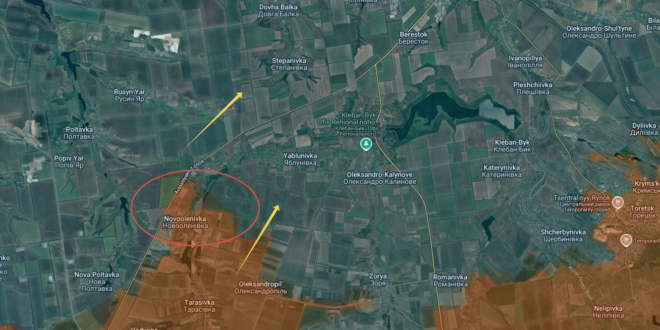The long awaited Istanbul negotiations between Russia and Ukraine took place, and though I have complained of the ‘sideshow’ nature of these distractions, today’s session is worth mentioning for what it revealed about Russia’s stance.
Firstly, it must be said outright that all doomers who claimed Russia was capitulating, and that Putin was again being ‘led by the nose’ toward a Minsk-3-style disaster were proven wrong. By all accounts, the Russian team was even firmer than expected on the chief demands.
Let’s also mention that Ukraine had already admitted their only goal in the negotiations was to push for a truce or ceasefire with Russia, as it has now become the common agenda between Zelensky and Europe to force Russia into a 30-day ceasefire. This would be pushed into indefinite status so that European troops can be injected into theater and the conflict frozen for good, while Ukraine is pumped up to the gills with more lethal aid.
Starting off, the Ukrainian side appeared to try and ‘intimidate’ the Russian side by dressing in military fatigues, while the Russian side donned formal wear:
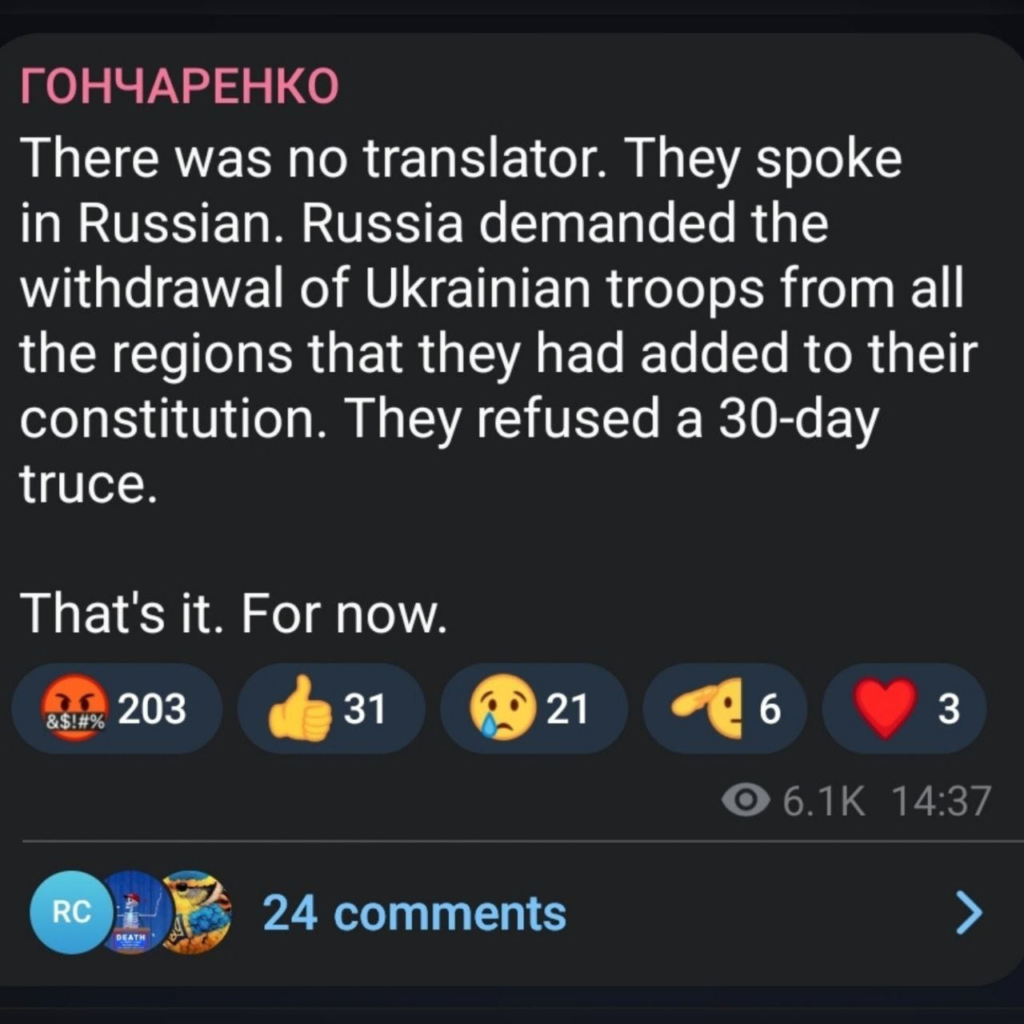
As he notes above, the Russian side apparently refused any ceasefire offers and demanded Ukraine’s withdrawal from the four regions of Kherson, Zaporozhye, LPR, and DPR. However, where it gets spicy is the claim that Russians gave Ukraine an ultimatum: take this deal or we’ll demand a fifth region next time.

If only Ukraine were so lucky.
In fact, Russian sources have corrected this version to 8 regions:
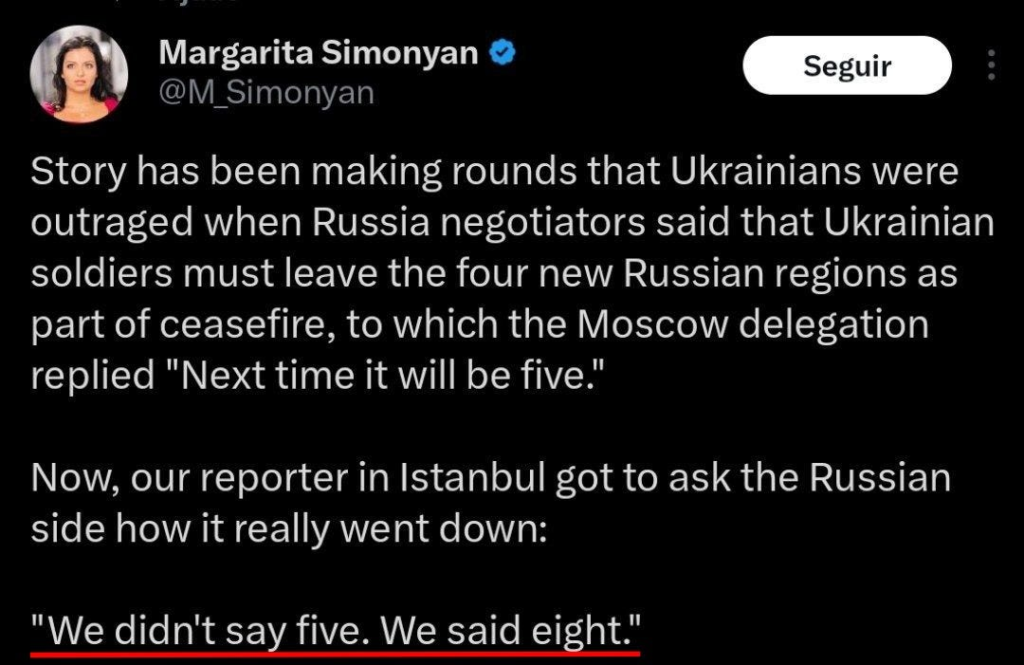
“We didn’t say five. We said eight.” Where are the doomers now, who claimed Putin would capitulate?
Presumably these eight regions would be the previous four of LPR, DPR, Kherson, and Zaporozhye, plus the stated Sumy, Kharkov, then Odessa and Nikolayev. This would pretty much cover the “likely” orange scenario below:
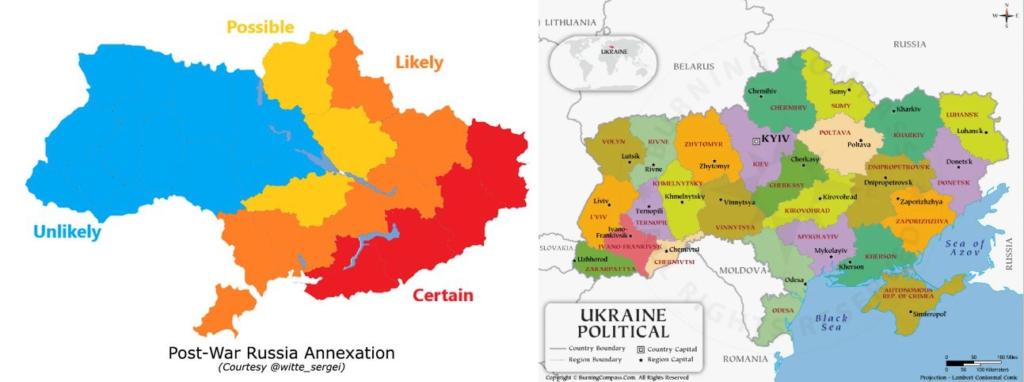
Goncharenko confirmed again:
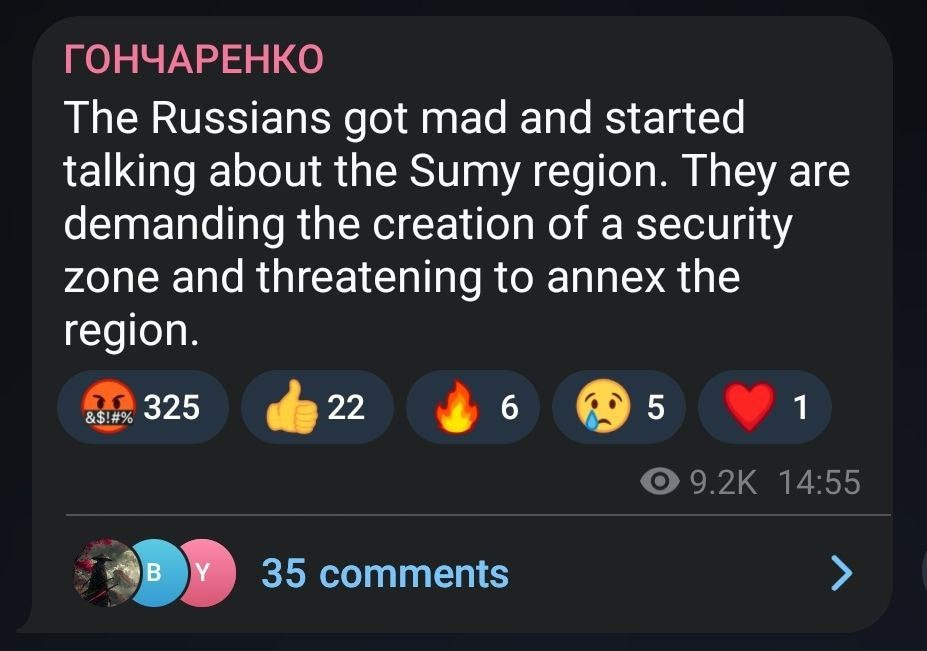
Other quotes include Russia essentially threatening that it is willing to fight forever to achieve its aims:
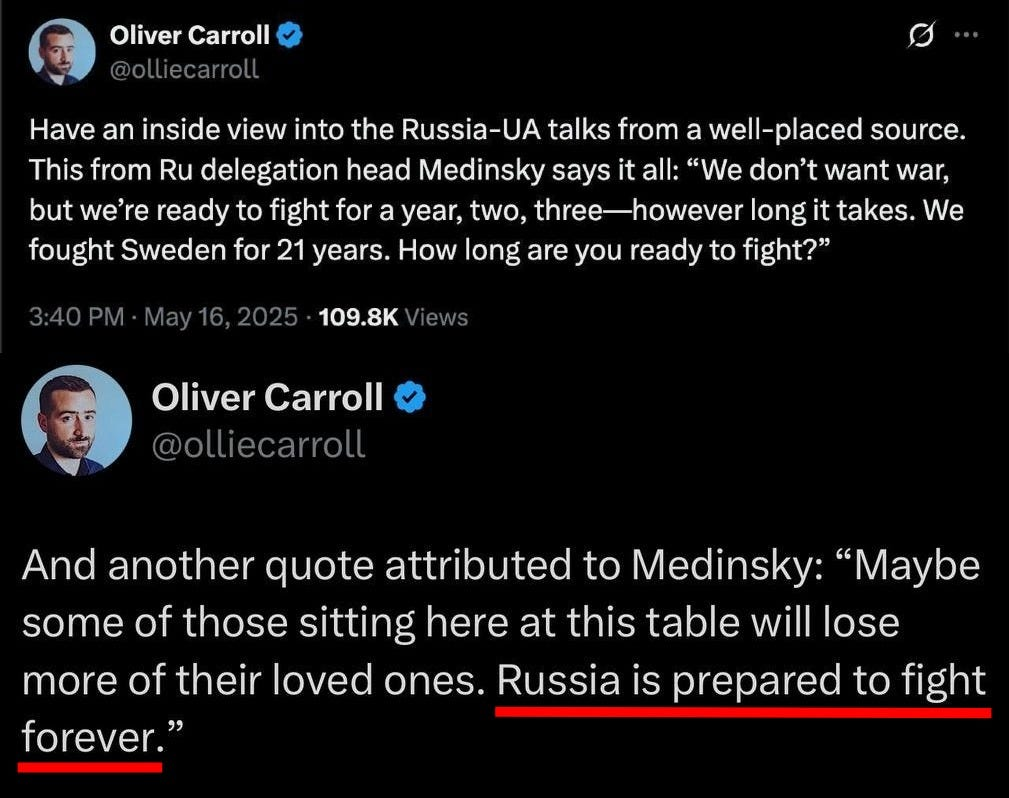
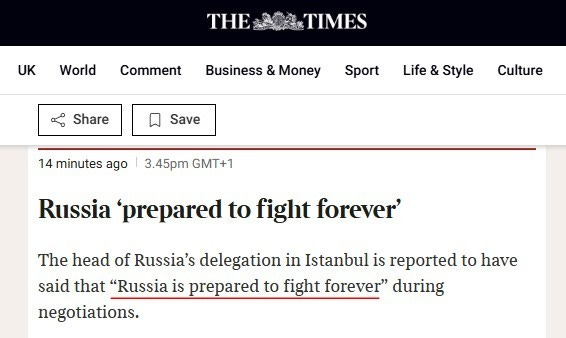
Another interesting quote:
One of the members of the Ukrainian delegation said during the negotiations that Russia plans to attack Poland in 2030.
The Russian delegation laughed, and Medinsky asked “not to transfer the negotiations into the fantasy genre.”The fact is, the West is only now slowly coming around to the reality that Russia is winning and has all the leverage to dictate terms. However, the West’s yellow press still takes great effort in softening this fact, as in the latest article from NYT which tries to claim that Russia is demanding disproportionately more than it should based on battlefield gains:
It’s beyond ludicrous levels of sophistry to try to spin Russia’s current advances as “inches” when Ukraine’s defenses are collapsing on every front. The article brings up Putin’s March quote, wherein he relayed his opinion that Russia is close to finishing Ukraine off:
“We have reason to believe that we are set to finish them off,” Mr. Putin said, adding: “People in Ukraine need to realize what is going on.”But of course, as per usual the article trots out the canard that Russia is incurring a very “high cost” for its ‘meager’ gains. Such a high cost that even MediaZona was forced to stop updating Russian losses after they had drooped to such an ‘inconveniently’ low level.
Let us again revisit the topic of Russian losses and manpower regeneration, since we have some new data at our disposal.
Yesterday Syrsky announced that the Russian contingent in Ukraine has now reached a whopping 640,000. Also, note his mention that Russia has transitioned the conflict into a ‘war of attrition’, which is an important acknowledgement:
I have dug up the past three years’ of updates on Russia’s troop totals—here’s what the data confirms:
In 2023, Bloomberg announced Russia’s troop count at 420,000:
In 2024, head of Ukrainian military intelligence Vadim Skibitzky revealed to the Economist the number had reached 514,000:
And in early 2025? It had swelled to 600,000:
We find that Russia’s troop count is increasing approximately by 100,000 in the Ukrainian theater each year.
The most obvious question follows: what kind of “massive losses” can Russia possibly be experiencing if it’s able to balloon its numbers by 100k troops each year?
Just two days ago Putin said Ukraine press-gangs 30k men a month, while Russia has 50-60k monthly volunteer sign-ups:
But let’s try out a few new calculations to really plug in those numbers.
You see, the one area of Russia’s manpower regeneration that every other analyst misses is Russia’s contract-based recruitment. Everyone calculates net losses versus volunteer sign-ups without understanding that the vast majority of Russia’s army in Ukraine are now contract troops, constantly churning through contract expirations.
With an AI bot’s help, I managed to crunch some of these numbers:
First we start with the basis that Russia had about 450k troops prior to going full contract. That is, after late 2022 where Russia launched the mobilization for 300k, adding to the ~150k it already had.
So, the challenge becomes to find how did Russia go from ~450k to the current 640k while churning both losses and contract non-reenlistments. As a quick aside, here’s a recent real Russian Army ad. Take special note of the “1 year of service” term being advertised:
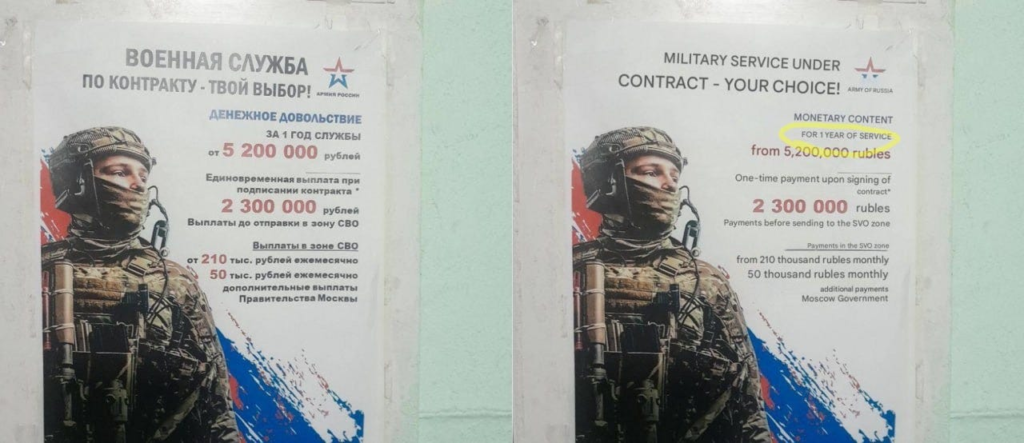
First, how do we know which of the service terms are most popular, 6 month, 1 year, or 2 year?
AI guesstimates as follows:

This is reasonable enough.
If you take the ‘average’ of 6, 12, and 24 months (42 / 3), you get about 14 months. That means, if Russia recruits 350,000 contract soldiers per year (~30,000 per month x 12, using a lower baseline estimate), most of that pool is being wiped out every 14 months due to contract expiry. However, a certain amount will re-enlist. How can we calculate a re-enlistment percentage? AI shares its thoughts:
In peacetime, modern militaries often see reenlistment rates between 40% and 60% for first-term contracts, with higher rates among career NCOs and specialists.
In high-casualty, high-stress wars, reenlistment rates typically drop. For example, during the U.S. wars in Iraq and Afghanistan, first-term reenlistment rates for combat troops sometimes fell below 40%, especially in units with high casualties.It goes on to say:
Given the above, a reenlistment rate of 30–40% is a reasonable estimate for Russian contract troops in Ukraine.It notes that re-enlistment would likely be lower for those choosing 6 month terms, and higher for those choosing 2 year terms, because they represent more ‘career-minded’ and incentivized personnel.
But let’s assume it averages out to the stated 30-40%, we get something like the following:
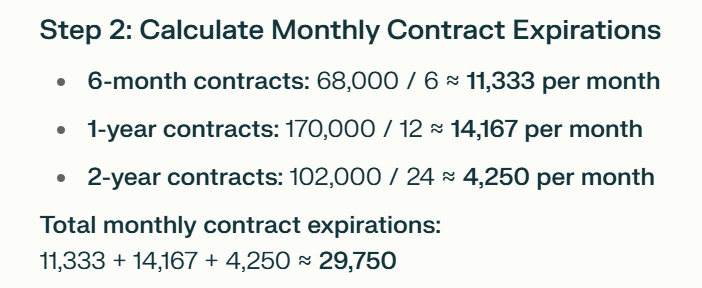
Out of this ~30k number, ~11k or so will re-enlist—though it may be higher.
But for the sake of argument, we get something like:
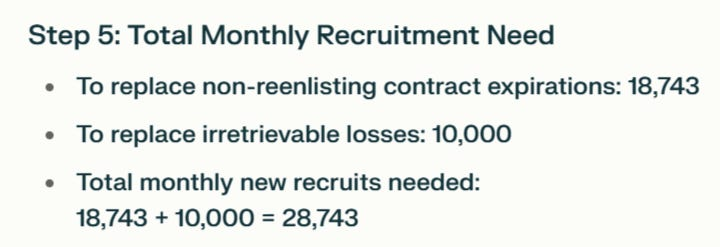
In other words, Russia may be losing up to 18-20k soldiers per month just to contract expirations. Then there’s at least another 10,000 per month irretrievable losses, which is both KIA and maimed beyond repair. This comes out to about 5,000 purely KIA per month, or 160 per day.
Latest figures from the likes of MediaZona and Trump’s own hintings are in line with this. For instance, it was reported Russia hit the 100k ‘confirmed dead’ milestone on March 29th, and then the 108k milestone ~45 days later on May 15th. Dividing the 8,000 increase into 45 days we get exactly 177 KIA per day. Irretrievable wounded would likely be the same number per day, so we can estimate 300-350 total losses per day (~10k/month), which would need to be covered by new recruitment.
To cover 10k hard losses, plus ~20k contract expiries, plus an additional 8k monthly growth in order to sustain the proven 100k per year force expansion, Russia would need to recruit nearly 40k per month. Putin in the video above says Russia does 50-60k per month. You can fudge the numbers around a little here or there, for instance if you believe Russia takes higher losses than 10k per month—let’s say 15k—then add another 5k on top of Russia’s necessary monthly recruitment, or lower the contract expirations a bit.
Also, recall that Russia is reportedly standing up other reserve armies that do not even count toward the 640,000 contingent in Ukraine, as we reported on recently. Depending on the growth of those reserve forces we can assume that either Russia’s monthly hard losses or the contract expirations are lower than expected; either that or Putin’s new 50-60k recruitment number is actually accurate, which would cover everything including new reserves growth.
There’s a slight caveat to the above: it’s an oversimplification based on static numbers, when in reality Russia’s force is growing and would require a multiplier that would over-complicate my point. But the general numbers should give a rough idea of what we’re dealing with in regard to the ratios of contract churn, losses, net force generation growth, etc.
To reiterate the most important point: when your entire force generation relies on limited contracts, it becomes absolutely necessary to assume an equation that allows for a huge monthly churn of contracts—i.e. people who choose not to re-enlist. The only question is how big this percentage should be; AI assumes 37% as a re-enlistment average—maybe you can argue Russians are “more patriotic” and a far higher percentage of them do re-enlist. It’s hard to know for sure, but it certainly can’t be 100%. 30-65% at most seems realistic. Officers would be much higher, grunts lower. 6 month, 1 year, and 2 year averages out to precisely 14 months, which means every 14 months the entire period’s worth of recruitment is churned over, less re-enlistments.
A quick note on Ukraine’s situation, which I’ve mentioned before, but would like to repeat for new subscribers. How is Ukraine able to retain its force composition despite presumably much higher losses?
Here’s an illustration of how relatively easy it is to recruit enough people to sustain losses:
Let’s say Ukraine loses 500-600 hard losses per day, which could be 250-300 KIA and 250-300 maimed. This would be 15-18k per month. If you believe the number is double that, then pretend it’s 30k a month total.
The point is this: Ukraine has 24 oblasts, with each of them having many cities, villages, towns, settlements, etc. Let’s say Ukraine needs a 15-30k monthly replenishment as noted above. To make the point, let’s even use the higher figure. That means Ukraine needs to press-gang 30k people per month, which comes out to 1,000 per day, from the entire country. Divide that by 24 oblasts, we get 41 people from each oblast per day.
A cursory search tells me each Ukrainian oblast has on average 1,500 total settlements of all kinds, though most are tiny. Imagine how easy it is to cull 41 people per day from a pool of 1,500 settlements. You virtually only need to capture a single person from a medium sized town each day, and your quota is met. This is a fairly easy feat. That means Ukraine does not really need to break a sweat to replace the upwards of 30,000 losses per month, even much less so if the losses are 15,000. And I don’t believe Ukraine has been taking particularly heavy losses in the past few months wherein the conflict had slowed down.
As such, we should not expect a sudden catastrophic breakdown, necessarily, but the continued slow attrition of Ukraine’s personnel until it hits a critical point sometime much later. But remember, Ukraine has no ‘contract churn’ like Russia—there is no de-mobilization in Ukraine at all. Every single ‘recruited’ soldier is there until death—with one caveat: Ukraine has a huge desertion problem, which can be compared to Russia’s contract de-mobilizations.
But mostly it means Ukraine’s entire monthly ‘mobilization’ figure (whether it’s 20k or 30k per month) represents loss replacement, unlike in Russia’s case where the majority likely represents contract churn, with losses being the smaller component. Therefore we can assume Ukraine’s losses are at a minimum 20-30k a month, and possibly more—in which case, Ukraine will not be ‘breaking even’ but slowly losing overall manpower. This could be accurate given that Zelensky seems to have previously said the AFU had 1+ million people, now reduced to a claimed 880,000.
On that topic, today another exchange of bodies took place with a reported 909 Ukrainian bodies exchanged for 34 Russian ones:
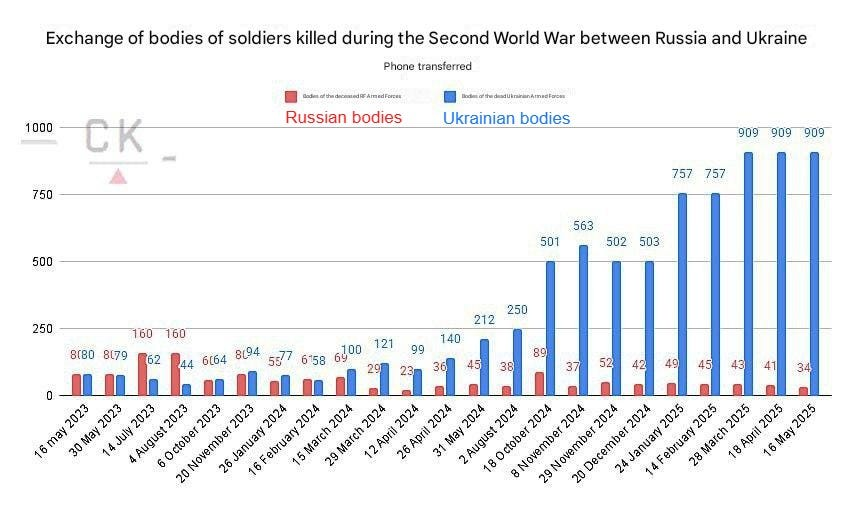
Today a "body exchange" took place(dead servicemen from both sides)
Ukraine received the bodies of 909 fallen servicemen, Russia - 34.
Graph of exchange of bodies of the dead for the years 23-25. In total, Russia transferred 7790 bodies, Ukraine 1408 bodies.It appears Russia has ‘capped’ the exchanges at precisely 909 for reasons unknown, but as per usual it’s a window into the loss disparities, though of course it doesn’t tell the full story.
Likewise another report on the agreed-upon prisoner exchange highlights something else I’ve long evangelized on:
The exchange of 1,000 for 1,000 prisoners, which Umerov announced, is undoubtedly good news.
According to some data, this is about half of all Russian prisoners of war held in Ukraine, and only about 15-20% of Ukrainian prisoners in Russia.
Thus, the majority of Russian troops will finally return home, while the majority of Ukrainian prisoners will still remain in custody. It would potentially be the largest prisoner exchange since the start of the conflict.
Military InformantWorry not, though, Ukraine remains confident of its manpower resources:

Now Ukrainian military figures believe Russia has already begun its offensive season:
🇷🇺🇺🇦 Russia has already effectively begun its summer offensive — spokesman for the Ukrainian Armed Forces group "Kharkov"
"You shouldn't expect a ceasefire in the near future," Shamshin added.Ukrainian ‘intelligence sources’ also told FT the same:
Ukrainian intelligence officials told the Financial Times that Russia appears to be gearing up for a larger offensive, moving forces to key hotspots on the battlefield, rather than signalling its readiness for peace talks.
The past several days have seen huge gains for Russia all across the critical Pokrovsk-Toretsk front, as well as others. There are so many advances it’s almost impossible to list them all.
Let’s start in the northern sector near Kupyansk down to Lyman. Russian forces have expanded territory on multiple axes there; the red circles represent new territorial gains:
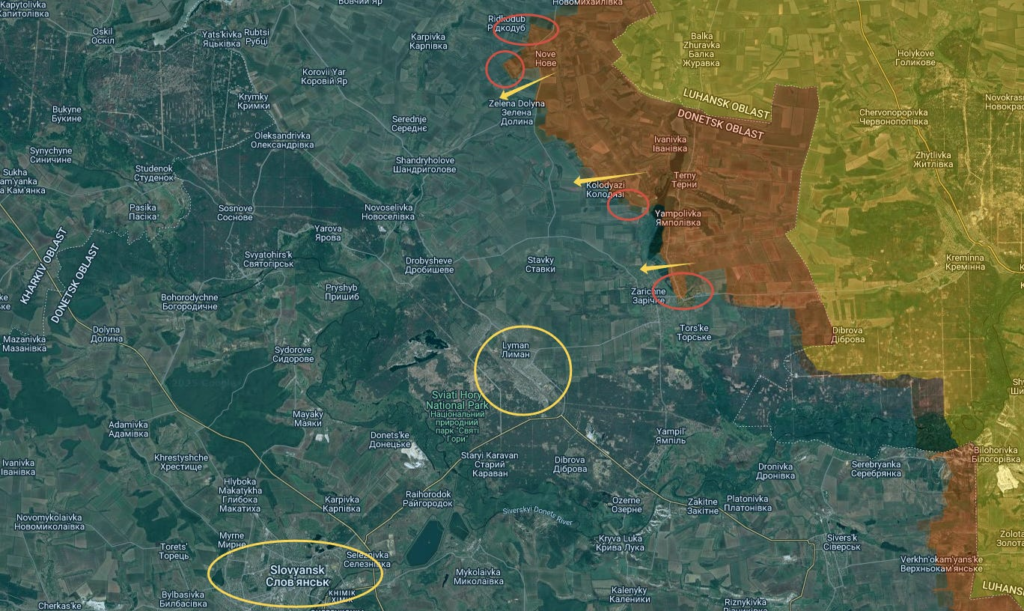
Most importantly, note how close RF is now coming toward Lyman, which itself is the final main gateway before Slavyansk.
Top Russian military channel RVvoenkor claims Torskoye was completely liberated, based on the direct statement of the Russian MoD:
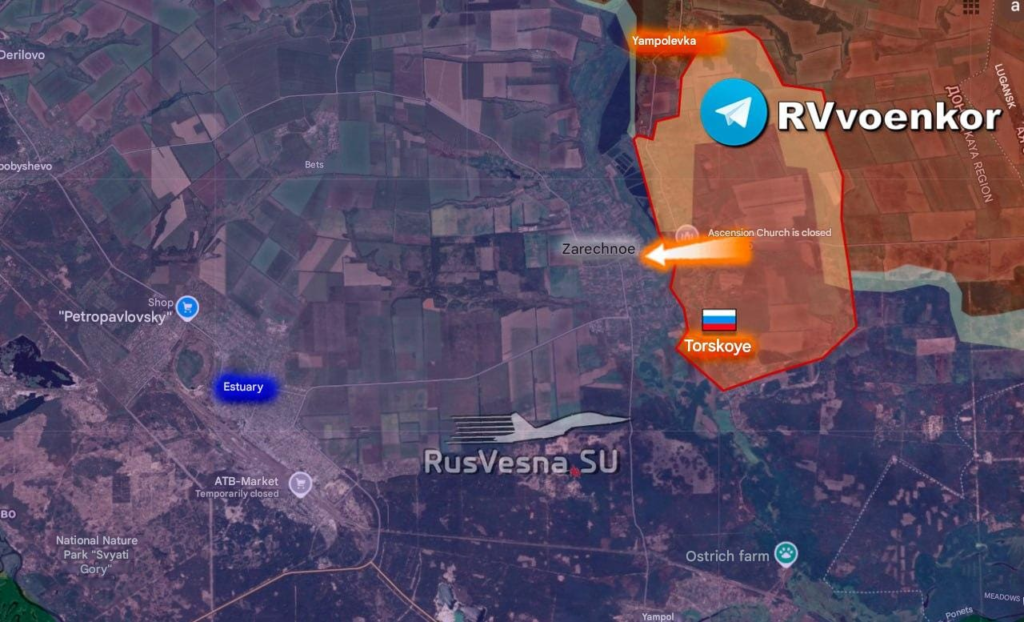
But other mappers have not shown that to be the case yet. Russian analyst Starshe Edda posted this about Torskoye:
The village of Torskoye has been liberated, our troops are moving towards Krasny Liman. I remember how almost two years ago, during the retreat and the heaviest fighting, the Guards 144th Division, led by its then division commander, clung to the forest regiments to the east of Torskoye and, bleeding, did not give in back. The Torskoye salient was formed, where a patch of land, shelled from three sides, was defended by the Steel Infantry and did not allow the enemy to cut off this bridgehead. Then, having withstood all the enemy's attacks, we went on the offensive and now Torskoye is ours. Glory to our Warriors, living and dead!The geolocation shown had Russian troops of the 144th Guards Motor Rifle Division only entering the village, not fully liberating it:
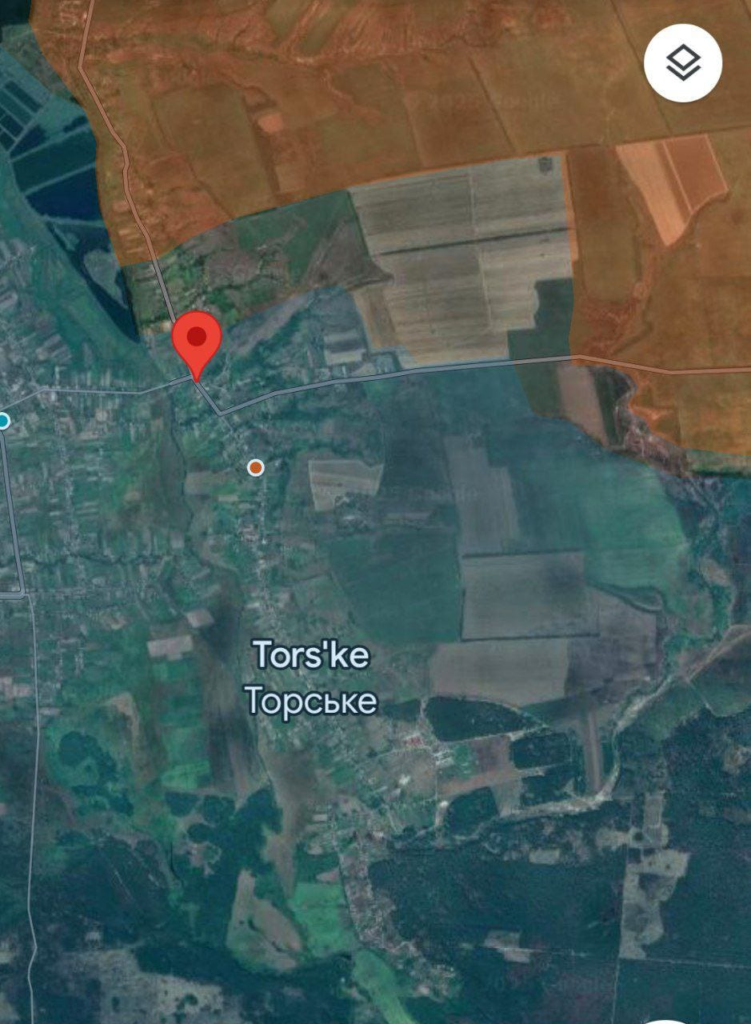
And Suriyak likewise contradicts the above:
Despite the Russian MOD announcement about the complete capture clashes with Ukrainian Army continue along the road that leads to the center of Tors'ke.We’ll have to wait and see.
There were gains further north near Stepy but we’ll focus on the more important directions for now.
Further south, Russian troops came closer to finishing off Chasov Yar, capturing new blocks:
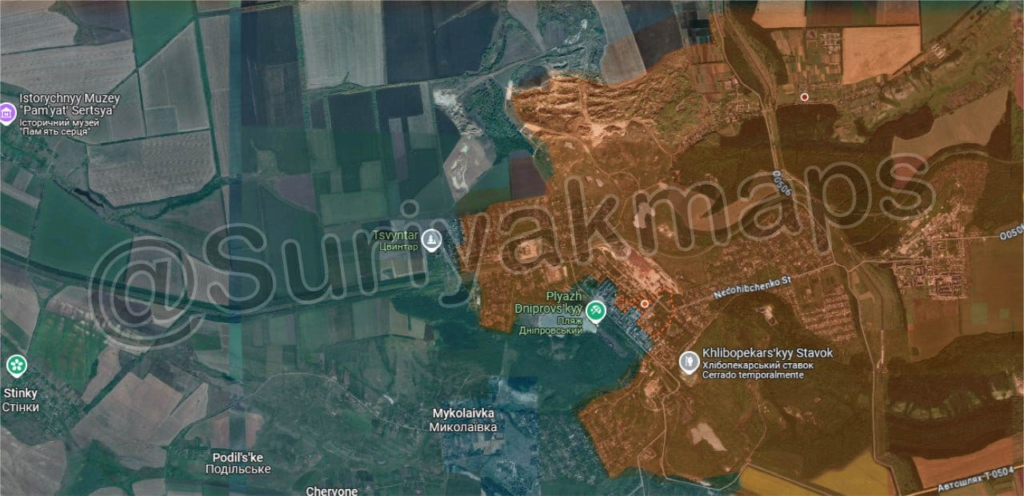
To the west near Velyka Novosilka, Russian forces likewise expanded control to the east of Komar
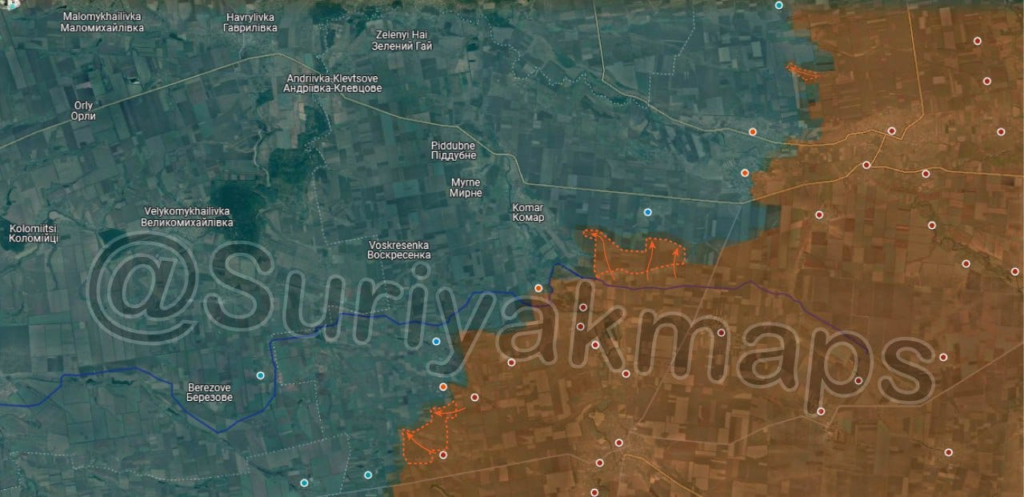
And just to the west, seen on the bottom of the map above, Russian forces captured Volnoye Pole at 47.87481178077348, 36.6859345132803 geolocation:
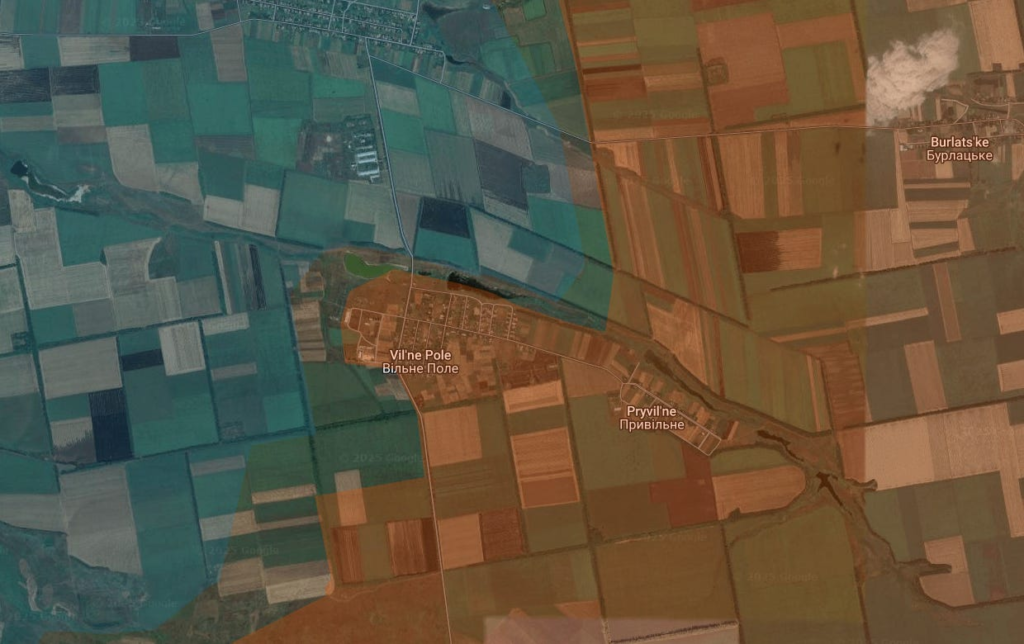
Units of the 5th Guards Combined Arms Army of the "East" group of forces took the village of Volnoye Pole in the South Donetsk direction. The administrative border of the Dnipropetrovsk region in this area is about 7 km away.But let’s get to the meat of the new advances—the Pokrovsk-Toretsk line. Russia has improved its positions all across the line, virtually everywhere.
On Pokrovsk’s western outskirts, Russian forces began advancing through Zvirove and Leontovychi, nearly reaching Pokrovsk’s physical city limits:

Now shift your focus slightly to the east of Pokrovsk where major activity took place as well. Circled in red are Malynovka, Myrolyubovka, and Mykolaivka, all of which were entirely or almost entirely captured:
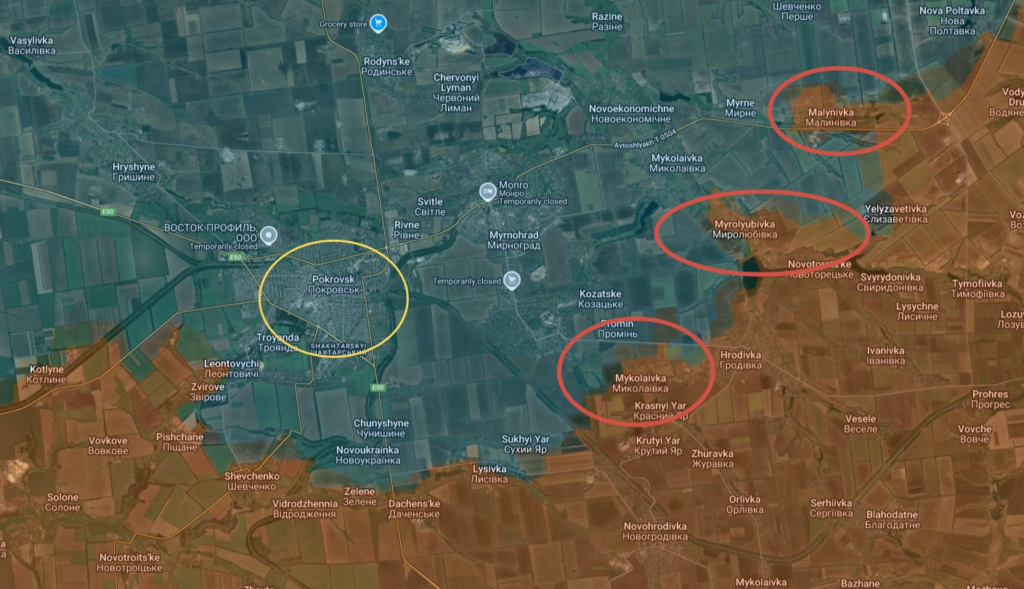
Successful assault on Myrolyubovka:
The same for Mykolaivka:
This is obviously creating a large enveloping cauldron around the Myrnograd-Pokrovsk agglomerate:
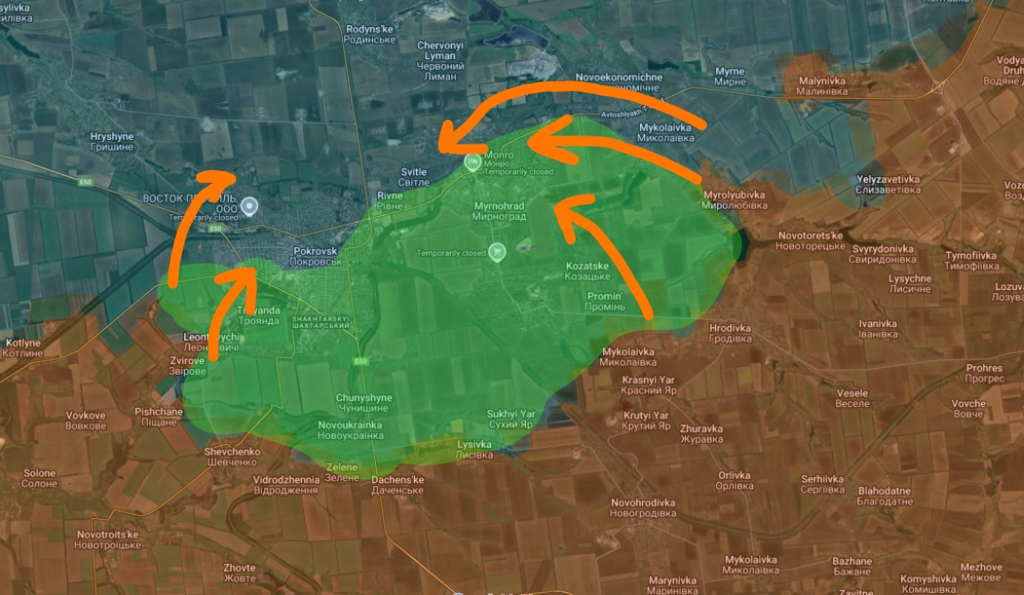
Further east from there toward Toretsk we have an even worse situation for the AFU—by far its most critical on the current front. Just south of Konstantinovka, this large 50-60km2 region between Stara Mykolaivka and Zorya has fallen nearly into a cauldron:
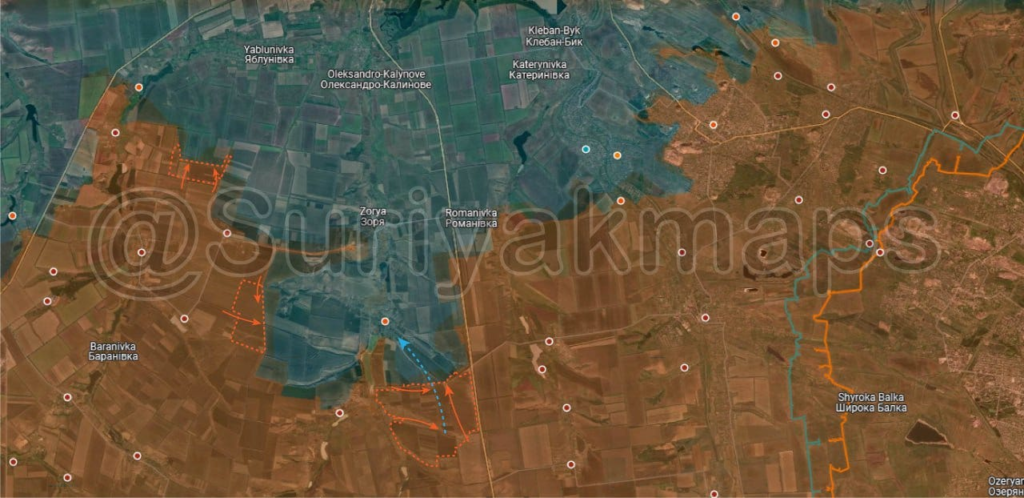
This was precipitated by this daring Russian advance along the main road toward Zorya:
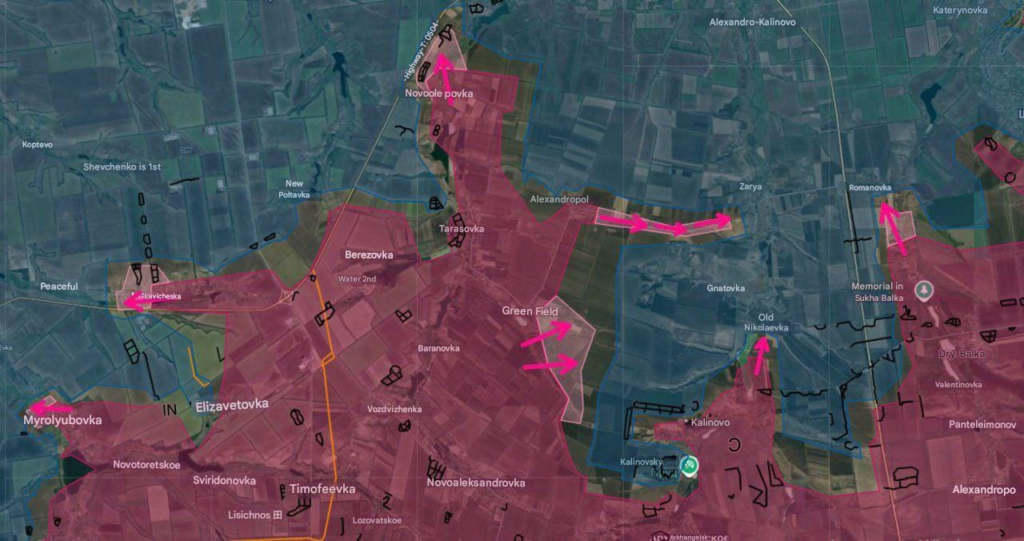
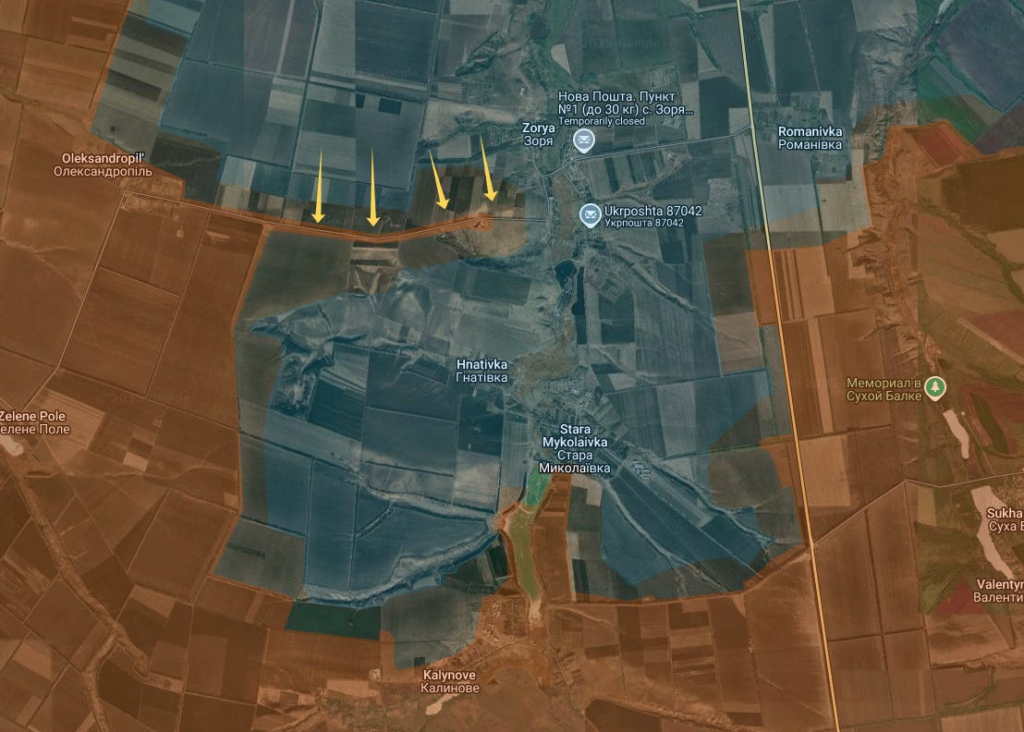
But if you thought that was it, you’d be wrong. On the western flank of this front, heading toward Konstantinovka, Russian forces further advanced in the Novoolenovka area:
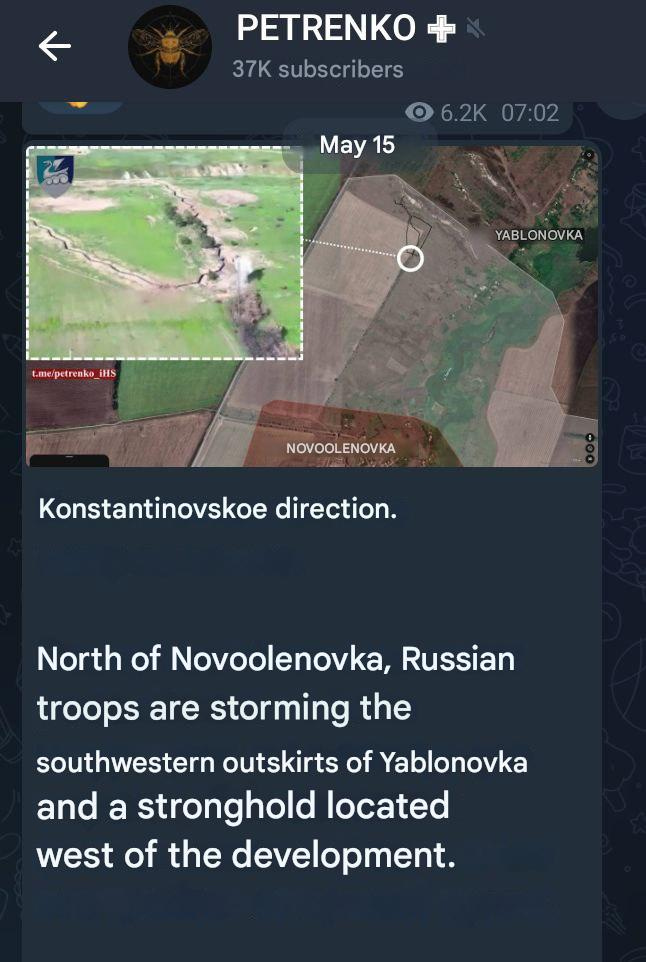
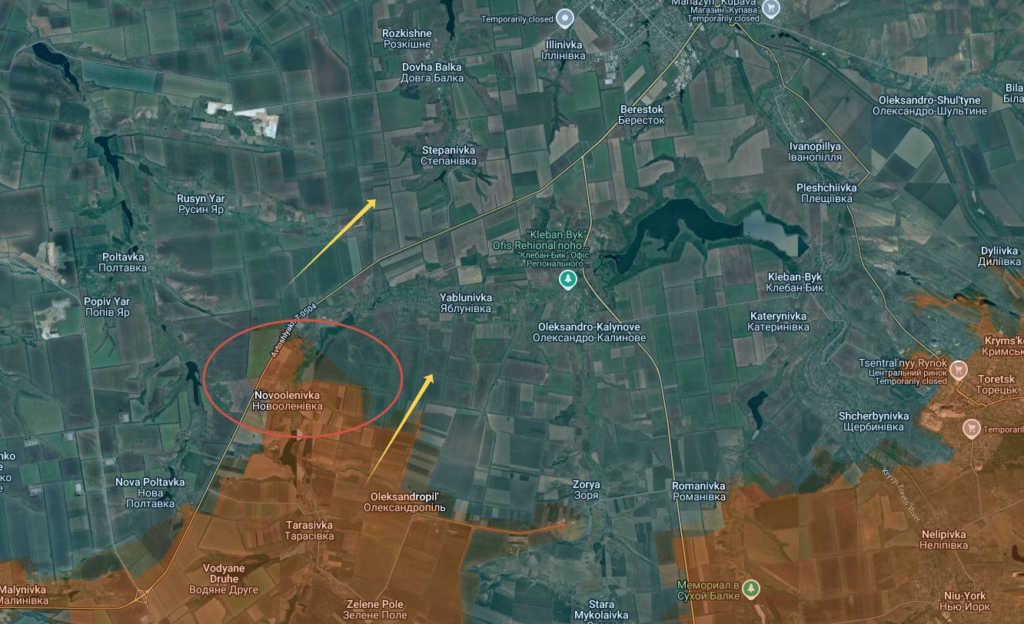
The Ukrainian fortifications there are serious, as the approaches to Konstantinovka have long been fortified:
There were other advances, particularly in the northern Sumy region where Russian forces took another bite out of Ukrainian ‘buffer’ territory across the border.
—
The commander of ‘Center Group’ who has been responsible for the Pokrovsk-Toretsk direction, as well as the capture of Avdeevka, has been Colonel General Andrey Mordvichev. Putin has now appointed him as the Commander-in-Chief of the entire Russian Ground Forces, replacing the aging Oleg Salyukov:
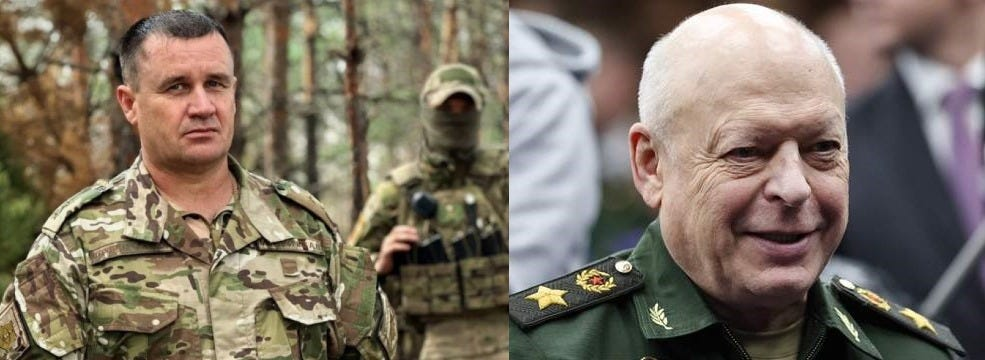
No, this wasn’t a ‘dismissal’ due to incompetence but simply that Russian law forbids generals past age 70. Salyukov turns 70 next week, so he is being moved over to the Russian National Security Council, which is a sign of Putin’s respect for him.
Mordvichev is notoriously hated by Ukrainians, being the man who was said to have led the Mariupol and Azovstal operations as well:

Putin had previously given him Russia’s highest honor:
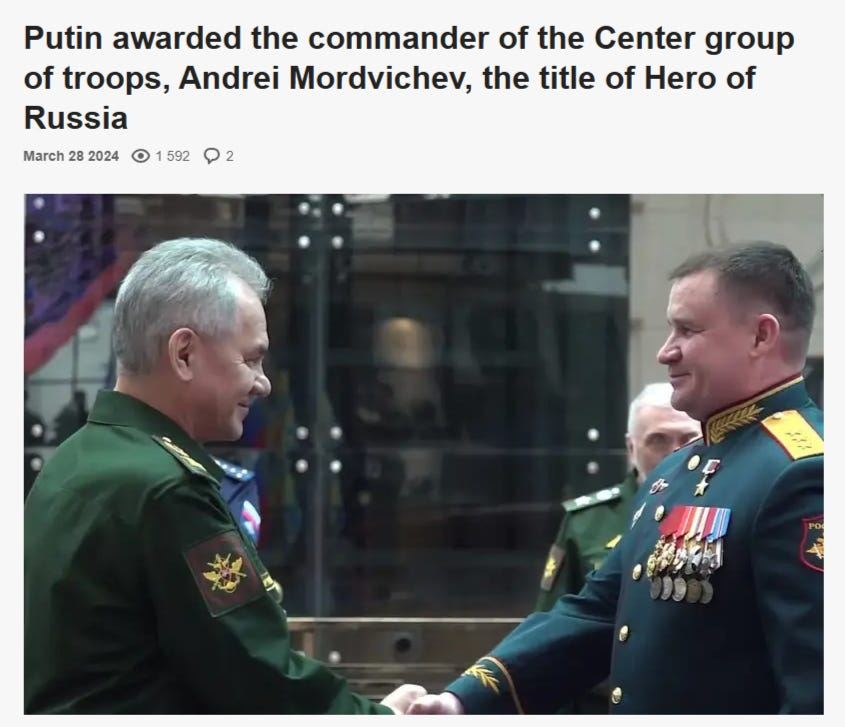
Mordvichev’s role as Center Group commander will be taken over by Valery Solodchuk, who reportedly was responsible for the success of the Kursk counter-operation that booted the AFU from Russian territory. Solodchuk had previously been designated as ‘killed’ in a Ukrainian strike:

Funnily enough, Mordvichev was likewise written off as killed by Ukraine’s state propaganda organs in 2022:

It just goes to show how laughable in retrospect Ukraine’s cheap propaganda has been.
Mordvichev appears to be a rising star and presumable shoe-in to eventually replace Gerasimov, depending on how he continues to do. But he’s not perfect, back in 2023 I had posted a video of his wherein he appeared to predict that the war would be over by ‘spring of 2024’—yet here we are.
—
Now that the long-awaited direct negotiations have ended, it’s back to the drawing board for the clown convention:
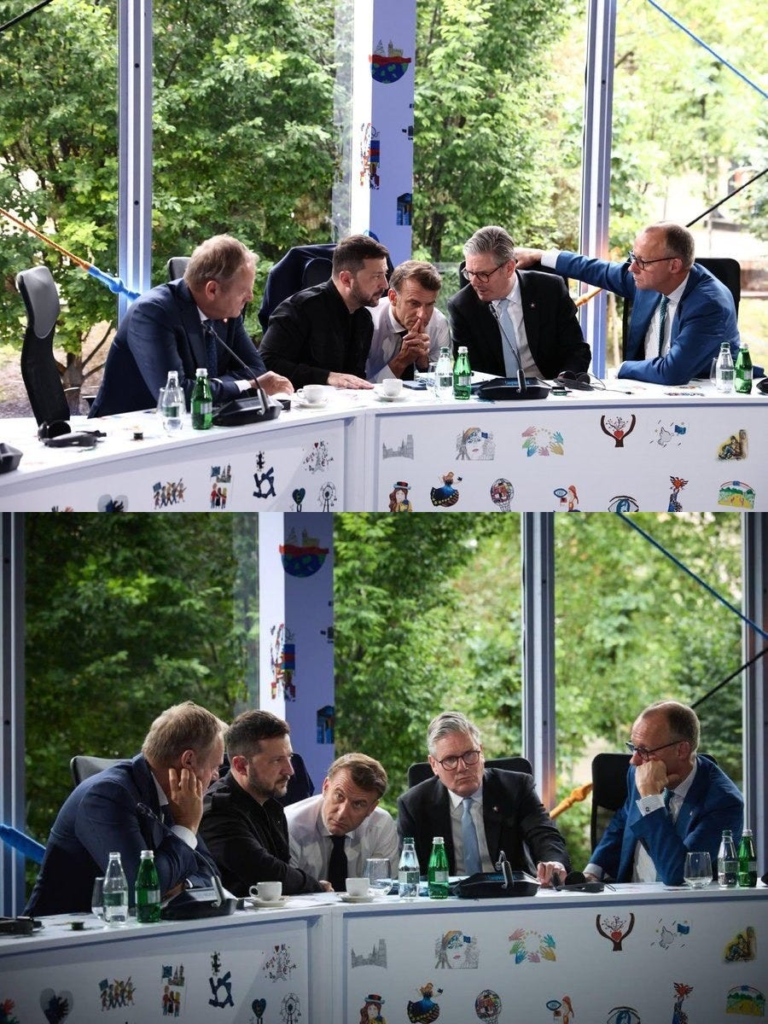
Western press is already reporting the negotiations as a big ‘victory for the Kremlin’, with Ukraine again walking away with nothing. The Euro-cabal’s plans have collapsed for now, with even Merz walking back from the edge by announcing Taurus missiles will not be supplied any time soon. Europe is again back to square one with Ukraine facing collapse amidst a looming large-scale Russian offensive; the ‘fateful allies’ are left with few choices.
We’ll finish with this thought-provoking reflection on negotiations, from a Russian channel:
Peace is worse than death. Capitulation means becoming a mob.
On 15.05.25, negotiations are to begin in Istanbul. The exact topic has not been announced, nor the format. But it is necessary to determine what our delegation should not allow.
On May 12, 2020, the philosopher and theorist of Russian nationalism, Konstantin Krylov, died, and on May 29, 1874, the British Christian writer G.K. Chesterton, an outstanding thinker and “king of paradox,” was born.
Krylov, observing Ukraine after 2014, said: “If people capitulate to Ukraine, you can do absolutely anything with them.” This was said before the start of the SMO.
From Chesterton's "The Passenger Tavern" (1914): "Today I have seen something worse than death. It is called peace."
Krylov and Chesterton were separated by time, space, and nationality, but they wrote about the same thing - the protection of human dignity, the preservation of man himself.
A monstrous experiment was conducted on Malorossiya: it was turned into a hybrid Ukraine - a country with a virtual history, a fictitious ethnicity. People were torn away from tradition, national roots. Rus was turned into Vyrus. Former Russians were forced to live exclusively in the material world, turned into a donkey running after a carrot suspended on a rope in front of their nose. For the sake of the European "carrot" everything was thrown into the trash: faith, nationality, native language, statehood. And the Ukrainians were offended, but not by themselves, but by Russia. This burning resentment lies at the heart of the conflict in Donbass, in the anger at the people who wanted to remain a people, and not a rabble.
There is no meanness that Ukrainians would not commit against their loved ones for the sake of war with Russia. The resentment was mixed with fear in the style of cannibal thinking: if I don’t eat, then I will be eaten (if I don’t send someone to the front, then I risk rotting near Toretsk).
To capitulate to Ukraine means to become a mob. Any economic and political justifications are irrelevant. Capitulation is equal to spiritual death.
The British are behind Zelensky and Co. on the Ukrainian side. And therefore, in Istanbul, there will be a distortion of meanings and capitulation to Ragulyatnik will advance.
Russia cannot retreat even a little, otherwise we will get a world that will be worse than death, even if this is not immediately realized.
The Kinburn Spit cannot be given to Ukraine, and not only because it blocks the free exit of Banderites from the Dnieper to the Black Sea. Suvorov defended the Kinburn Spit from the Turkish landing in 1787. This is the place of glory of Russian arms.
The Zaporizhzhya NPP cannot be handed over. Much Russian blood was shed in its defense, the "peaceful atom" is the banner of prestige of a normal state.
And it is so important to approach each point of bargaining with Ukraine. Trump is not a decree. For him, peace in Ukraine is a deal, for Russia it is a guarantee of survival. There are times when it is more useful to listen to writers than to politicians. These are the times. Eurasia Press & News
Eurasia Press & News
